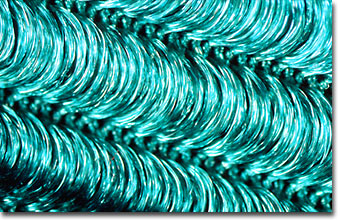Spike (M.I.) Walker
Lycra Fabric
English photomicrographer Spike (M.I.) Walker has been a consistent winner of the Nikon Small World competition for many years and has published many articles and a book about microscopy. Featured below is a photomicrograph of a small swatch of Lycra fabric.

|
A piece of LycraŽ was cut from a swimming costume and pinned to a microscope slide for observation and photomicrography. The sample was illuminated with two small electronic flash heads (Bowem Macro-lite) having in-built tungsten focusing lamps, one at 45 degrees and the other at 25 degrees to the horizontal. The photomacrographic equipment consisted of a Zeiss Tessovar. Photographed with Fujichrome Velvia. (12.5x) |
Originally developed as a replacement for rubber, LycraŽ is a man-made elastomeric fiber, invented and produced solely by DuPont. It is known for its ability to stretch up to six times its original length, then snap back to its starting size with no loss to its spring. Generically, these fibers are known as spandex in the United States and Canada, and as elastane in Europe.
LycraŽ is a segmented polyurethane. While it appears to be a single, continuous thread, it is actually a bundle of tiny filaments. It's this unique molecular structure that gives LycraŽ its built-in, lasting elasticity.
LycraŽ is something of a social fiber, never used alone. It is always combined with other fibers, either natural and/or man-made. Usually white with dull luster, it is readily dyed and absorbs very little moisture. It melts at about 480 degrees Fahrenheit (250 degrees Celsius) and yellows upon prolonged exposure to heat or light. LycraŽ is used in such apparel as foundation garments, support hosiery, and swimsuits. It is light in weight and cool; it is resistant to deterioration from body acids; and it is easily laundered and quick-drying.
